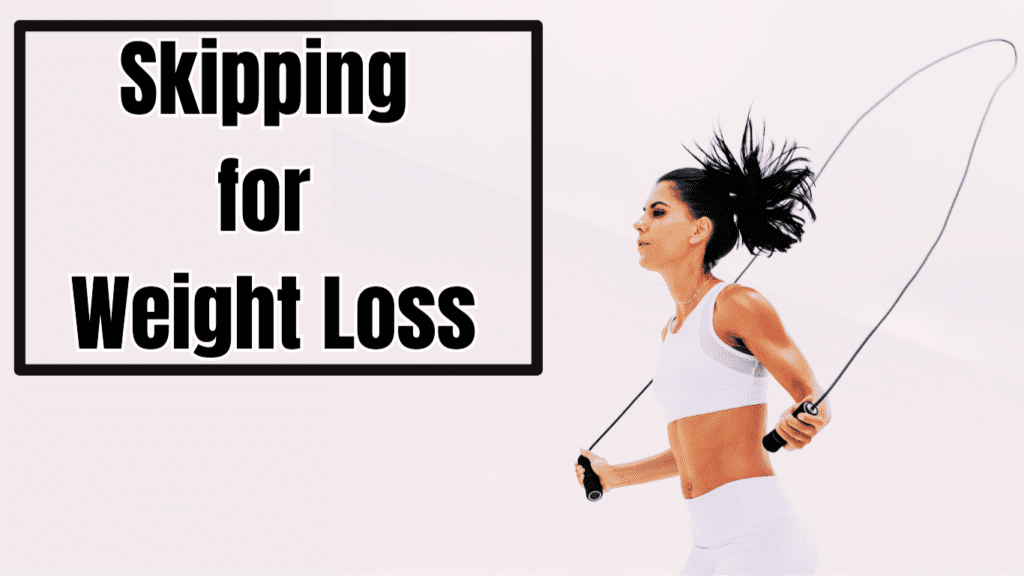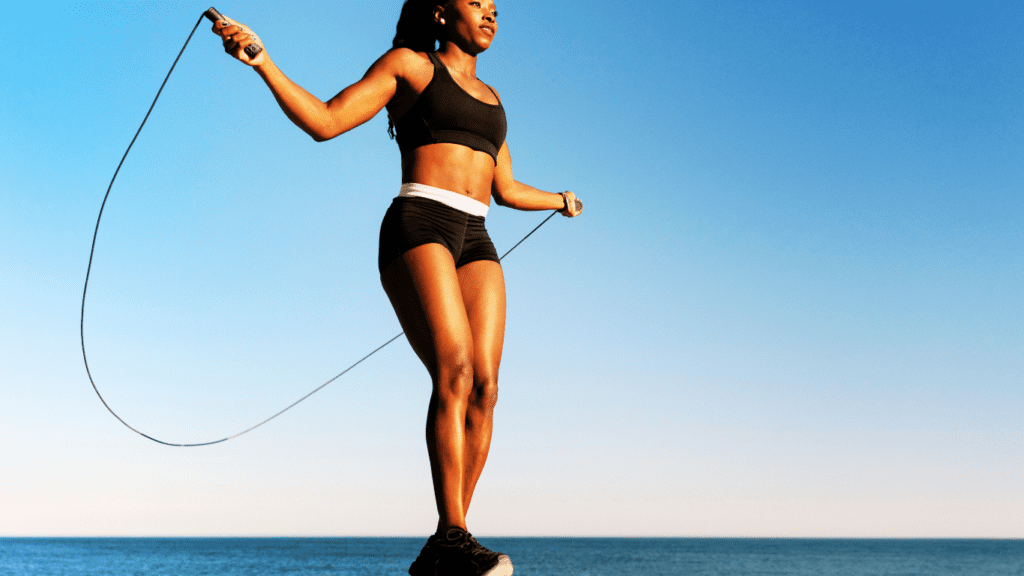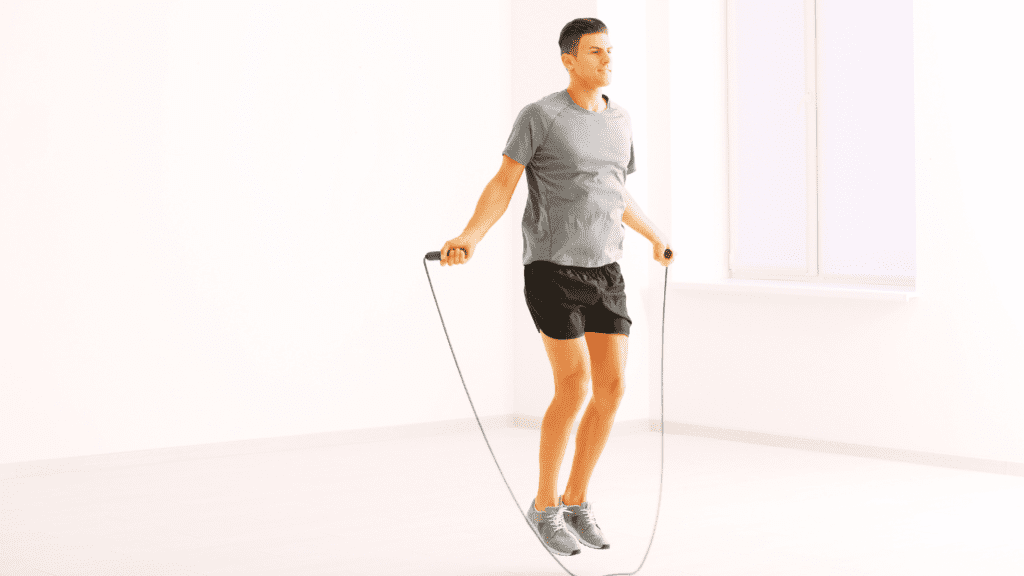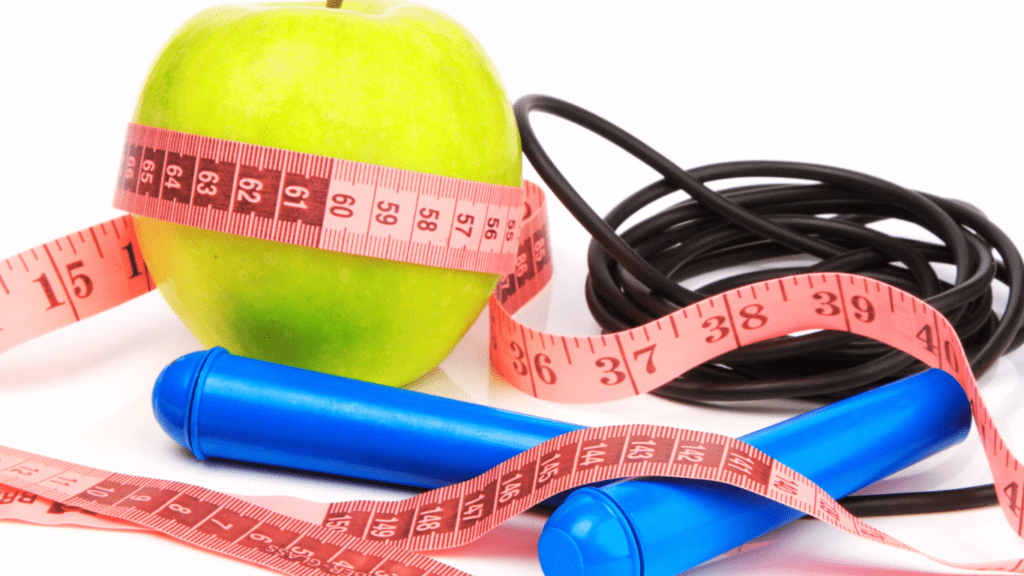Jump Into Fitness: Skipping for Weight Loss Explained
In this article, we will dive deep into the numerous benefits of skipping for weight loss, covering everything from calorie-burning potential and cardiovascular health to tailored workout plans for different fitness levels, ensuring you have all the tools you need to effectively integrate this enjoyable exercise into your fitness routine.
Skipping for weight loss is one of the most simple yet highly effective exercises you can incorporate into your fitness routine. Despite its straightforward nature, many people overlook this classic childhood activity as a serious workout option. However, skipping (or jumping rope) is not only fun and affordable, but it’s also accessible for just about anyone. Whether you’re just starting out on your fitness journey or you’re a seasoned gym-goer, the humble jump rope could be the perfect addition to your routine, especially if your goal is to shed some pounds.

Why Choose Skipping for Weight Loss?
1. High-Calorie Burn
Skipping can burn up to 10-15 calories per minute. This means that in just a short 15-minute session, you could burn more calories than you would on a 30-minute jog. Here are some reasons why skipping for weight loss is highly effective:
- Efficient Calorie Burning: Great for those with limited time.
- Quick Workouts: A short session can yield significant results.
2. Cardiovascular Benefits
Skipping provides an intense cardiovascular workout, which is essential for burning fat and improving heart health. The benefits include:
- Improved Heart Health: Strengthens your heart and lungs.
- Increased Endurance: Boosts your stamina over time.
3. Full-Body Engagement
When you skip, you engage your entire body, which offers several advantages:
- Muscle Toning: Works your calves, thighs, core, and shoulders.
- Boosted Metabolism: Helps in long-term fat loss.
Advantages of Skipping for Weight Loss
1. Adaptability
You can easily adjust your skipping sessions according to your fitness level. Here’s how:
- Start Slow: Focus on technique before increasing speed.
- Progressive Intensity: Gradually challenge yourself as you improve.
2. Convenience
Unlike some workouts that require expensive equipment or a gym visit, all you need for skipping is a jump rope and a bit of space. This makes it incredibly easy to fit into your routine:
- Anywhere, Anytime: Perfect for quick sessions at home, before work, or during breaks.
- Low-Cost Equipment: A jump rope is affordable and easy to store.
3. Low-Impact Exercise
When done correctly, skipping is a low-impact exercise, making it safer for your joints compared to running or other high-impact activities. This means:
- Safer for All Levels: Suitable for people of various fitness levels.
- Gentle on Joints: Ideal for those concerned about injury.
Skipping for Weight Loss: Key Benefits and Comparisons Chart:
| Benefit | Skipping | Running | Cycling | Swimming |
|---|---|---|---|---|
| Calories Burned per Minute | 10-15 | 8-12 | 7-10 | 7-10 |
| Primary Muscle Groups Engaged | Full-body (legs, core, arms, shoulders) | Legs, Core | Legs, Core | Full-body (legs, core, arms) |
| Cardiovascular Benefit | High (Elevates heart rate quickly) | High | Moderate | High |
| Workout Duration for Effective Fat Loss | Short (10-15 mins for high intensity) | Moderate (30-60 mins) | Moderate (30-60 mins) | Moderate (30-60 mins) |
| Impact on Joints | Low (if done correctly) | High (high-impact on joints) | Moderate (depends on surface) | Low (gentle on joints) |
| Accessibility & Equipment | Very accessible (just a jump rope needed) | Requires running shoes, road/track | Requires bike | Requires pool access |
| Adaptability for Different Fitness Levels | High (easy to adjust pace) | Moderate (may be challenging for beginners) | Moderate (depends on cycling level) | Low (advanced swimming required for fat burning) |
| Ideal for | Weight loss, toning, cardio | Weight loss, endurance | Endurance, muscle building | Full-body fitness, endurance |
If you’re looking for an effective, efficient, and enjoyable way to achieve your weight loss goals, consider giving skipping a try. As we continue in this article, we’ll delve deeper into why skipping for weight loss is such a powerful method and how you can maximize its benefits.
Stay tuned as we break down the steps to incorporate skipping into your routine and how you can customize your sessions for maximum fat-burning results. Whether you want to lose weight, tone your body, or just find a new way to stay active, skipping could be the perfect fit for your lifestyle.
How Long Should You Jump Rope Every Day To Lose Weight Video
How Skipping Helps with Weight Loss
When it comes to effective workouts, skipping for weight loss stands out as one of the best options available. One of the primary reasons is its impressive calorie-burning potential. In fact, studies show that skipping can burn more calories than many traditional cardio exercises. On average, you can expect to burn between 10 to 15 calories per minute while skipping. To put this in perspective, running can burn around 8 to 12 calories per minute, and cycling averages around 7 to 10 calories per minute. This means that for those looking to shed pounds, skipping for weight loss can provide a more intense and efficient workout in less time.
Subscribe And Get Our Free E-Book:Unlocking The Power Of Nutrition-Supplements, Substitutes, and Superfoods!
Not only does skipping help in burning calories, but it also plays a significant role in fat loss. This is largely because skipping is a high-intensity workout. When you engage in skipping, your body taps into its fat reserves more effectively, especially when done consistently. The key here is that skipping elevates your heart rate quickly, which helps to maximize your fat-burning potential. By incorporating skipping into your routine, you can transform your workout sessions into powerful fat-burning opportunities.
Another advantage of skipping for weight loss is that it serves as a full-body workout. Many people mistakenly think that cardio exercises only target the legs or the core, but skipping is different. It engages multiple muscle groups at once, including:
- Legs: Your calves and thighs are heavily involved, helping to build strength and endurance.
- Core: Skipping requires core stabilization, which tones your abdominal muscles.
- Arms and Shoulders: As you turn the rope, your arms and shoulders also get a solid workout, enhancing muscle definition.
This comprehensive engagement of various muscle groups means that when you skip, you’re not just burning calories; you’re also building strength and improving your overall fitness level.

Cardiovascular Benefits
One of the most compelling aspects of skipping for weight loss is its effect on cardiovascular health. Skipping elevates your heart rate quickly, which is essential for a healthy cardiovascular system. A strong heart can pump blood more efficiently, ensuring that your muscles receive the oxygen they need during exercise.
Improved cardiovascular health not only supports your skipping routine but also enhances your ability to perform other physical activities. This is crucial for weight loss because better cardiovascular health allows you to engage in more intense workouts without feeling fatigued. Essentially, the more active you can be, the more calories you burn, leading to effective weight loss over time.
High-Intensity Interval Training (HIIT) Potential
Another fantastic way to utilize skipping for weight loss is by incorporating it into High-Intensity Interval Training (HIIT) workouts. HIIT is characterized by short bursts of intense activity followed by brief rest periods, making it an excellent method for maximizing fat loss. Here’s how you can adapt skipping into a HIIT routine:
- Warm-Up: Begin with a 5-minute warm-up, gradually increasing your skipping speed.
- Work Intervals: Skip at maximum effort for 30 seconds. This intensity will elevate your heart rate and push your body into the fat-burning zone.
- Rest Intervals: Follow this with a 30-second rest period. Use this time to catch your breath and prepare for the next round.
- Repeat: Continue this cycle for 15-20 minutes, mixing in other exercises if desired, such as push-ups or burpees.
By incorporating HIIT into your skipping for weight loss routine, you can significantly accelerate your fat loss results. The short bursts of activity increase your metabolism and promote afterburn, meaning you’ll continue to burn calories even after your workout has ended.
In summary, skipping for weight loss is a highly effective workout choice for anyone looking to lose weight. With its remarkable calorie-burning potential, ability to engage multiple muscle groups, cardiovascular benefits, and adaptability to HIIT workouts, skipping is a comprehensive exercise that offers great results.
If you’re ready to experience the benefits for yourself, consider adding skipping to your weekly routine. Not only will it help you lose weight, but it will also improve your overall fitness, making your workouts more enjoyable and productive. So grab a jump rope and start skipping your way to a healthier, fitter you!
Benefits of Skipping for Different Fitness Levels and Body Types
Skipping for weight loss is an exercise that can be beneficial for people at various fitness levels and body types. Its adaptability makes it a fantastic choice, whether you’re a complete beginner or a seasoned athlete. Let’s explore how different individuals can incorporate skipping for weight loss into their routines while maximizing its benefits.
Beginners
If you’re new to exercise or haven’t been physically active for a while, starting with skipping for weight loss might feel intimidating, but it doesn’t have to be. Here are some tips for beginners:
- Start Slow: Begin with a slow pace. Focus on your form and get comfortable with the rhythm of skipping. It’s more important to establish a good technique than to skip quickly right away.
- Short Durations: Keep your sessions short, around 5 to 10 minutes at first. This will help your body adjust without overwhelming it.
- Gradually Increase Intensity: As you build confidence and stamina, gradually increase your skipping duration and intensity. Try adding an extra minute each week, or increase your pace slightly to challenge yourself.
By starting slowly and allowing your body to adapt, you’ll be more likely to stick with skipping for weight loss in the long term.

Intermediate Fitness Enthusiasts
For those who already have a basic level of fitness, skipping can be an excellent way to enhance your workouts. Here’s how intermediate users can take their skipping to the next level:
- Add Variations: Incorporate different techniques into your routine. Consider trying double-unders, where the rope passes under your feet twice for each jump, or crossovers, which involve crossing your arms in front of you while you skip.
- Increase Pace: Skip at a faster pace to elevate your heart rate and challenge your endurance. This is a great way to push your limits and burn even more calories.
- Endurance Building: Aim for longer sessions, gradually increasing to 15-20 minutes. Focus on maintaining proper technique while you enhance your stamina.
By refining your skills and adding variety, you can make skipping for weight loss both challenging and enjoyable.
Advanced Users
For advanced fitness enthusiasts, skipping can serve as a powerful tool to further challenge your strength and stamina. Here’s how you can elevate your skipping routine:
- Weighted Ropes: Consider using weighted jump ropes to intensify your workouts. These ropes add resistance, helping to build muscle in your arms and shoulders while boosting your overall strength.
- High-Intensity Intervals: Incorporate high-intensity intervals by alternating between periods of maximum effort and short rest periods. For example, skip at your highest intensity for 30 seconds, followed by 15 seconds of rest. This method not only enhances your cardiovascular fitness but also promotes effective fat loss.
By implementing these advanced techniques, you can ensure that skipping for weight loss continues to challenge you and supports your fitness goals.
Overweight or Out-of-Shape Individuals
If you are overweight or haven’t exercised in a long time, skipping can still be a viable option, provided you approach it with caution. Here are some considerations:
- Lower-Impact Alternative: Compared to running, skipping can be lower impact, especially if you focus on form and technique.
- Adapt Intensity: To avoid injury, adapt the intensity by skipping on softer surfaces, like grass or a gym mat, instead of hard concrete. This can help reduce stress on your joints.
- Take Breaks: Listen to your body and take breaks as needed. It’s essential to allow yourself to rest and recover.
By gradually incorporating skipping for weight loss into your routine, you can enjoy the benefits while prioritizing your safety and comfort.
Elderly or People with Joint Issues
For the elderly or individuals with joint issues, skipping may not be the best option due to its high-impact nature. Here are some recommendations:
- Alternatives: Consider low-impact alternatives like swimming or cycling, which provide cardiovascular benefits without stressing your joints.
- Modified Movements: If you want to incorporate skipping movements, consider low-impact options. For example, you could step instead of jumping, mimicking the motion without the strain.
- Consult a Professional: Always consult with a healthcare professional or a fitness trainer who can guide you on safe exercises tailored to your abilities.
While skipping for weight loss can be a fantastic option for many, it’s crucial to listen to your body and choose workouts that suit your individual needs.
In conclusion, skipping for weight loss is a versatile exercise that can cater to various fitness levels and body types. Whether you’re a beginner, intermediate, or advanced user, there are effective ways to incorporate skipping into your routine. For those who are overweight or have joint concerns, adapting the intensity or considering alternative exercises can lead to positive results. Remember to always prioritize safety and comfort in your workouts, and enjoy the journey to better health and fitness through skipping!
Practical Tips to Maximize Skipping Workouts for Weight Loss
If you’re ready to dive into skipping for weight loss, it’s essential to know how to get the most out of your workouts. Skipping is not only a fun and effective way to burn calories, but it can also improve your overall fitness level when done correctly. Here are some practical tips to help you maximize your skipping workouts for weight loss.
Choosing the Right Rope
Selecting the right jump rope is crucial for effective skipping for weight loss. Here are some factors to consider:
- Length: To find the right rope length, stand on the middle of the rope and pull the handles up toward your armpits. If they reach that height, the rope is the correct length. If not, look for a longer or shorter rope.
- Weight: Heavier ropes can provide more resistance and can be beneficial for strength building. However, lighter ropes are easier to handle and allow for faster skipping, which is great for cardio.
- Material: The material of the rope can affect your performance. PVC ropes are lightweight and suitable for beginners, while leather ropes provide better durability and speed, making them ideal for advanced users.

Proper Skipping Form
Proper technique is essential to avoid injury while maximizing the benefits of skipping for weight loss. Follow these guidelines to ensure you maintain good form:
- Light Footwork: Keep your feet light and avoid jumping too high. Aim for just a few inches off the ground. This will reduce the impact on your joints and help maintain your rhythm.
- Use Your Wrists: Instead of swinging your arms, use your wrists to turn the rope. This technique allows for a quicker, more efficient skipping motion and reduces strain on your shoulders and arms.
- Maintain Good Posture: Stand tall with your shoulders back and your core engaged. Keeping your head up and your gaze forward can help maintain balance and prevent unnecessary strain on your neck.
How Long Should You Skip?
The duration of your skipping sessions will depend on your fitness level. Here’s a breakdown of recommended times to get the most out of skipping for weight loss:
- Beginners: Start with 5-10 minutes of skipping. This allows your body to adapt to the movement without overdoing it. Focus on form and technique during this time.
- Intermediate: Once you feel comfortable, gradually increase your time to 15-20 minutes. This duration will start to elevate your heart rate and improve your endurance.
- Advanced: Aim for 30 minutes of continuous skipping. You can also incorporate intervals of high-intensity bursts followed by short rest periods for an extra challenge.
To get the most out of your skipping workouts for weight loss, it’s important to adjust the duration and intensity based on your current fitness level. The following chart provides a guide on how to tailor your skipping sessions to match your skill level, maximize calorie burn, and improve overall fitness. By understanding how long and how intensely you should skip, you can set realistic goals and track your progress effectively. Whether you’re a beginner or an advanced jumper, this chart will help you structure your skipping workouts for optimal results.
Skipping for Weight Loss: Intensity vs Duration for Different Skill Levels Chart
| Skill Level | Recommended Duration | Intensity | Calories Burned (Approx.) | Key Focus Areas |
|---|---|---|---|---|
| Beginner | 5-10 minutes | Low: Steady skipping | 50-80 calories | Focus on form, building stamina |
| Intermediate | 15-20 minutes | Moderate: Varying speeds | 100-150 calories | Improving rhythm, endurance |
| Advanced | 30 minutes | High: Intervals or double-unders | 200-300+ calories | Intensity, speed, advanced techniques |
- Beginners (5-10 minutes): Shorter sessions help you focus on form and coordination without overloading your body, allowing you to build a foundation.
- Intermediate (15-20 minutes): Longer sessions increase cardiovascular endurance and stamina, while varying speeds add intensity to elevate the workout.
- Advanced (30 minutes): Longer, high-intensity sessions push your fitness level further, with advanced techniques like double-unders that increase calorie burn and muscle engagement.
The chart follows a progressive structure, matching workout duration and intensity with your fitness level. This approach prevents injury, enhances endurance, and maximizes weight loss by gradually increasing challenge and intensity over time.
Sample Workout Plan
For a balanced approach to skipping for weight loss, consider the following sample workout plan:
- Warm-Up: 5 minutes of dynamic stretching.
- Skipping Session:
- Beginners: 5-10 minutes of steady skipping.
- Intermediate: 15-20 minutes with varying speeds.
- Advanced: 30 minutes, mixing intervals and variations (e.g., double-unders).
- Strength Training: Follow your skipping session with 20-30 minutes of bodyweight exercises (like squats and push-ups) to tone muscles.
- Cool Down: Finish with 5-10 minutes of stretching to relax your muscles.
Incorporating Skipping into Your Routine
To get the most out of skipping for weight loss, try to integrate it into a balanced workout routine. Here are some ideas:
- Alternate with Strength Training: Combine your skipping sessions with strength training exercises. This not only enhances muscle toning but also promotes fat loss by elevating your metabolism.
- Mix with Other Cardio: Pair skipping with other forms of cardio like cycling or swimming. This variety keeps your workouts interesting and engages different muscle groups.
- Set Specific Goals: Create weekly or monthly goals for your skipping sessions, such as duration, intensity, or frequency, to keep yourself motivated.
Warm-Up and Cool Down
Never underestimate the importance of warming up and cooling down when engaging in skipping for weight loss.
- Warm-Up: Begin with a 5-minute warm-up to get your blood flowing and prepare your muscles for activity. Dynamic stretches like arm circles, leg swings, and gentle jogging in place are great options.
- Cool Down: After your workout, take 5-10 minutes to cool down with static stretches, focusing on your calves, thighs, and shoulders. This helps to prevent stiffness and promotes recovery.
Incorporating these practical tips into your skipping for weight loss routine will help you maximize the benefits of this fantastic workout. By choosing the right rope, maintaining proper form, and adhering to recommended durations, you can create a fun and effective workout regimen. Remember to incorporate skipping into a balanced fitness plan that includes strength training and other forms of cardio, and always prioritize warming up and cooling down. With commitment and consistency, skipping can be an enjoyable path to achieving your weight loss goals!
The Pros and Cons of Skipping
When considering skipping for weight loss, it’s important to weigh the advantages and disadvantages of this effective workout. Skipping can be an incredibly beneficial addition to your fitness routine, but like any exercise, it may not be suitable for everyone. Let’s explore the pros and cons of skipping for weight loss to help you make an informed decision.
Pros
High-Calorie Burn
One of the biggest advantages of skipping for weight loss is its impressive ability to burn calories. Skipping can burn approximately 10-16 calories per minute, depending on your weight and intensity level. This makes it one of the most efficient cardiovascular exercises available. If you are looking for a way to maximize calorie expenditure in a short amount of time, skipping is a great choice. Just a 20-minute session can provide an effective workout that rivals longer cardio exercises such as running or cycling.
Portable and Convenient
Another significant benefit of skipping for weight loss is its portability. You can easily skip almost anywhere—at home, in the gym, or outdoors—without requiring a lot of space or elaborate equipment. All you need is a skipping rope and a small area to move around. This convenience means you can fit in a workout whenever you have a spare moment, whether it’s during your lunch break or while traveling. Having such an accessible workout can help you stay consistent with your fitness goals.
Full-Body Workout
Skipping is also an excellent full-body workout. It engages multiple muscle groups, including your legs, arms, shoulders, and core. This engagement makes it a great way to tone your body while also providing cardiovascular benefits. When you incorporate skipping into your routine, you’re not just burning calories; you’re also building strength and endurance. This total-body engagement means you can achieve a comprehensive workout in a relatively short time, making it an efficient choice for those pressed for time.
Low Cost
When it comes to fitness, cost can be a significant factor. Thankfully, skipping for weight loss requires minimal investment. A good quality skipping rope is relatively inexpensive, making it accessible to nearly everyone. Unlike gym memberships or fancy equipment, a skipping rope can fit easily into your budget. Additionally, you don’t need special workout attire or gear, which makes it an appealing option for those looking to get fit without breaking the bank.

Cons
High-Impact Nature
While there are many benefits, it’s essential to consider the high-impact nature of skipping for weight loss. The repetitive jumping can put significant stress on the joints, particularly for those with existing knee or ankle issues. If you have a history of joint problems or are recovering from an injury, skipping may exacerbate your condition. In such cases, it’s crucial to consult a healthcare professional before starting a skipping routine or consider lower-impact alternatives like swimming or cycling.
Learning Curve
Another downside to skipping for weight loss is the learning curve associated with the exercise. For beginners, mastering the rhythm and timing of skipping can be challenging and sometimes frustrating. Many newcomers may struggle to find their groove, leading to potential discouragement. However, it’s important to remember that practice makes perfect. With time and persistence, you can improve your technique and enjoy the benefits of skipping. It’s helpful to start slow and focus on building your skills gradually.
Not Suitable for Everyone
Lastly, while skipping is beneficial for many, it may not be suitable for everyone. Individuals with significant obesity or joint issues may find skipping too strenuous on their bodies. If you fall into this category, it’s crucial to listen to your body and consider alternative exercises that provide similar cardiovascular benefits without the high impact. Options like walking, cycling, or using an elliptical machine can be excellent substitutes that allow you to stay active without risking injury.
Skipping for weight loss offers a variety of advantages, including high-calorie burn, convenience, a full-body workout, and low costs. However, it’s important to acknowledge the potential downsides, such as its high-impact nature, the learning curve for beginners, and its suitability for certain individuals. Ultimately, whether you choose to incorporate skipping into your fitness routine should depend on your personal fitness level, goals, and any existing health conditions. By weighing the pros and cons, you can determine if skipping for weight loss is the right choice for you!
Common Mistakes to Avoid in Skipping for Weight Loss
While skipping for weight loss can be a highly effective workout, many people make common mistakes that can hinder their progress or lead to injury. To ensure that you get the most out of your skipping sessions and stay safe while doing so, it’s crucial to be aware of these pitfalls. Let’s discuss some common mistakes and how to avoid them.
Improper Form
One of the most significant issues when it comes to skipping for weight loss is improper form. Many beginners jump into skipping without understanding the right technique, which can lead to inefficient workouts and potential injuries. Here are some common mistakes to watch out for:
- Jumping Too High: A common mistake is jumping too high when skipping. This not only wastes energy but also increases the impact on your joints. Instead, aim for a height of just a few inches off the ground. Keeping your jumps low will help you maintain rhythm and control while reducing stress on your knees and ankles.
- Poor Wrist Control: Another mistake is using your arms instead of your wrists to swing the rope. Relying on your arms can lead to fatigue and disrupt your rhythm. Focus on using your wrists to turn the rope, allowing for a quicker and more efficient motion. This technique keeps your arms relaxed and reduces strain on your shoulders.
- Hunching Over: Many people tend to hunch over while skipping, which can lead to back pain and poor posture. Make sure to stand tall, with your shoulders back and your chest lifted. Engaging your core while maintaining good posture will not only improve your skipping form but also enhance your overall workout effectiveness.
Overtraining
Another critical mistake to avoid is overtraining. This is particularly relevant for beginners who are excited to start skipping for weight loss. While it’s great to be enthusiastic, jumping into a rigorous skipping routine too quickly can lead to issues like shin splints or joint pain. Here’s how to avoid overtraining:
- Start Slow: If you’re new to skipping, it’s essential to start with shorter durations. Begin with just 5-10 minutes of steady skipping, focusing on your form. As your fitness level improves, you can gradually increase the time and intensity.
- Listen to Your Body: Pay attention to how your body feels during and after your workouts. If you experience pain or discomfort, take a break. Rest days are crucial for recovery and will help you avoid injuries that could sideline you.
- Mix Up Your Routine: To prevent overuse injuries, consider alternating skipping with other forms of exercise. Incorporating strength training or other cardiovascular activities can provide variety and allow different muscle groups to recover.

Skipping on Hard Surfaces
The surface you choose to skip on can significantly impact your workout experience and safety. A common mistake is skipping on hard surfaces, such as concrete or asphalt. This can increase the impact on your joints and lead to discomfort or injury. Here are some tips for selecting a suitable surface for skipping for weight loss:
- Opt for Softer Surfaces: Whenever possible, choose to skip on softer surfaces like grass, rubberized tracks, or exercise mats. These surfaces provide more cushioning, reducing the stress on your joints and making your workout more comfortable.
- Consider Indoor Options: If outdoor surfaces are limited, consider skipping indoors on a gym mat or a soft carpet. Just ensure you have enough space to move freely without any obstacles around you.
Avoiding these common mistakes can enhance your experience with skipping for weight loss and help you achieve your fitness goals safely. By maintaining proper form, being mindful of your training intensity, and selecting appropriate surfaces, you can enjoy the numerous benefits of skipping without the drawbacks. Remember, fitness is a journey, and taking the time to do it right will pay off in the long run. Stay consistent, listen to your body, and embrace the joy of skipping as a fun and effective way to lose weight and improve your overall health!
Skipping Workout Plans for Different Goals
Skipping for weight loss is an incredibly versatile exercise that can be tailored to suit various fitness levels and goals. Whether you are just starting, looking to enhance your existing routine, or aiming for a high-intensity workout, there’s a skipping plan for you. Below, we’ll outline sample weekly plans for different levels, ensuring you can find the right fit for your needs.
Beginner Plan for Skipping for Weight Loss
If you are new to skipping for weight loss, it’s essential to start slowly to build your endurance and technique. Here’s a sample beginner plan for your first week:
- Day 1:
- Warm-Up: 5 minutes of light stretching and jogging in place.
- Skipping Session: 10 minutes of basic skipping at a comfortable pace. Focus on form and maintaining a low jump.
- Cool Down: 5 minutes of stretching.
- Day 2:
- Rest Day: Allow your body to recover.
- Day 3:
- Warm-Up: 5 minutes of dynamic stretching.
- Skipping Session: 12 minutes of skipping, adding in 30 seconds of faster skipping every 3 minutes.
- Cool Down: 5 minutes of gentle stretching.
- Day 4:
- Rest Day: Focus on hydration and light activity like walking.
- Day 5:
- Warm-Up: 5 minutes of light jogging.
- Skipping Session: 15 minutes of skipping, alternating between normal pace and 1 minute of high intensity every 5 minutes.
- Cool Down: 5 minutes of stretching.
- Days 6 and 7:
- Rest Days: Take these days off to allow your body to adapt to the new activity.
This beginner plan focuses on building a solid foundation. As you progress, aim to increase your skipping time and incorporate different techniques.

Intermediate Plan for Skipping for Weight Loss
For those who have mastered the basics and are ready to kick it up a notch, the intermediate plan integrates various skipping techniques with high-intensity interval training (HIIT):
- Day 1:
- Warm-Up: 5 minutes of dynamic stretching.
- Skipping Session: 20 minutes alternating between basic skipping and double unders (jumping higher while turning the rope twice) for 1 minute at a time, followed by 1 minute of basic skipping.
- Cool Down: 5 minutes of stretching.
- Day 2:
- Strength Training: Focus on upper body workouts like push-ups and shoulder presses.
- Day 3:
- Warm-Up: 5 minutes of light jogging.
- HIIT Skipping: 30 seconds of high-speed skipping followed by 30 seconds of rest, repeated for 15 minutes.
- Cool Down: 5 minutes of stretching.
- Day 4:
- Rest Day: Gentle activities like yoga or walking.
- Day 5:
- Warm-Up: 5 minutes of dynamic stretching.
- Skipping Technique Work: Spend 5 minutes on different techniques—crossovers, high knees, and double unders. Then, do 15 minutes of alternating techniques with short rest periods in between.
- Cool Down: 5 minutes of stretching.
- Days 6 and 7:
- Active Recovery: Engage in low-impact activities like cycling or swimming.
This intermediate plan will help enhance your endurance and improve your calorie-burning capacity through diverse techniques.
Advanced Plan for Skipping for Weight Loss
If you’re an advanced user looking to maximize your workout, this advanced plan combines high-intensity intervals with strength training:
- Day 1:
- Warm-Up: 10 minutes of dynamic stretching and light cardio.
- HIIT Skipping: 1 minute of high-intensity skipping followed by 1 minute of bodyweight exercises (like squats or push-ups). Repeat for 20 minutes.
- Cool Down: 5 minutes of stretching.
- Day 2:
- Strength Training: Focus on compound lifts to build overall strength.
- Day 3:
- Warm-Up: 10 minutes of light jogging.
- Circuit Workout:
- 3 rounds of:
- 1 minute of double unders
- 1 minute of push-ups
- 1 minute of regular skipping
- 1 minute of burpees
- Rest for 1 minute between rounds.
- 3 rounds of:
- Cool Down: 5 minutes of stretching.
- Day 4:
- Rest Day: Allow your body to recover and repair.
- Day 5:
- Warm-Up: 10 minutes of dynamic stretching.
- Skipping Intervals: Perform 30 seconds of maximum effort skipping followed by 30 seconds of rest for a total of 20 minutes.
- Cool Down: 5 minutes of stretching.
- Days 6 and 7:
- Active Recovery: Incorporate low-impact activities or sports for fun.
This advanced plan aims to push your limits, building both cardiovascular fitness and muscular endurance.
Low-Impact Plan for Skipping for Weight Loss
For those concerned about joint impact, there are alternatives to full skipping. Here’s a low-impact plan that keeps you active without excessive strain:
- Day 1:
- Warm-Up: 5 minutes of dynamic stretching.
- Shadow Skipping: 15 minutes of mimicking skipping movements without the rope. Focus on maintaining form and footwork.
- Cool Down: 5 minutes of stretching.
- Day 2:
- Rest Day: Engage in light activities.
- Day 3:
- Warm-Up: 5 minutes of light cardio.
- Side-to-Side Steps: 15 minutes of lateral movements to mimic the skipping motion, alternating with gentle marches in place.
- Cool Down: 5 minutes of stretching.
- Day 4:
- Rest Day: Light activities for recovery.
- Day 5:
- Warm-Up: 5 minutes of dynamic stretching.
- Modified Skipping: Perform 10 minutes of skipping with very low impact (like stepping side to side while turning the rope slowly).
- Cool Down: 5 minutes of stretching.
- Days 6 and 7:
- Active Recovery: Gentle walking or swimming.
No matter your fitness level or goals, there’s a skipping workout plan to fit your needs. Whether you’re just starting, seeking a challenge, or need a low-impact alternative, skipping for weight loss can be an enjoyable and effective addition to your routine. Keep your workouts varied, listen to your body, and enjoy the process as you work toward your fitness goals!
Skipping and Diet: The Synergy for Weight Loss
When it comes to achieving your weight loss goals, incorporating skipping for weight loss into your fitness routine is a powerful strategy. However, it’s essential to understand that exercise alone isn’t enough. To maximize your results, you need to consider the synergy between your skipping workouts and your diet. In this section, we will explore the importance of maintaining a caloric deficit, provide nutrition tips to enhance your skipping regimen, and discuss how tracking your progress can keep you motivated and on the right path.
Caloric Deficit and Skipping for Weight Loss
At the heart of any successful weight loss strategy is the concept of a caloric deficit. This means that you need to burn more calories than you consume. Skipping for weight loss is an excellent way to create that deficit. A typical 30-minute session of skipping can burn anywhere from 300 to 400 calories, depending on your weight and intensity. By regularly incorporating skipping into your routine, you can significantly contribute to your overall calorie expenditure.
However, it’s important to remember that you can’t out-exercise a poor diet. If you’re burning calories through skipping but consuming more than you need, you won’t see the results you desire. To achieve effective weight loss, aim for a balanced approach that combines your skipping workouts with mindful eating.

Nutrition Tips
To complement your skipping for weight loss, consider these nutrition tips that can help you make healthier choices:
- Eat Clean: Focus on whole, unprocessed foods such as fruits, vegetables, lean proteins, and whole grains. These foods are nutrient-dense and can help you feel fuller for longer, reducing the temptation to overeat.
- Stay Hydrated: Water is crucial for overall health and can also aid in weight loss. Sometimes, our bodies confuse thirst with hunger. Make it a habit to drink water throughout the day, especially before meals and workouts. Aim for at least 8 glasses of water daily, adjusting for your activity level and climate.
- Balance Your Plate: Ensure your meals contain a balance of macronutrients: proteins, fats, and carbohydrates. Incorporating healthy fats (like avocados or nuts) and protein sources (such as chicken or legumes) can help stabilize blood sugar levels, keeping you satisfied and energized for your skipping sessions.
- Mind Portion Sizes: Be aware of portion sizes, especially when consuming high-calorie foods. Using smaller plates can help manage portion control and prevent overeating.
- Plan Your Meals: Preparing meals in advance can prevent last-minute unhealthy choices. By having healthy meals and snacks on hand, you’ll be less likely to reach for processed options when hunger strikes.
Tracking Progress for Skipping for Weight Loss
To stay on track with your weight loss journey, consider using tracking tools that can enhance your experience. Here are some effective methods:
- Fitness Trackers: Devices like smartwatches or fitness bands can track your skipping sessions, monitor your heart rate, and estimate calories burned. These devices often provide valuable insights into your activity levels, helping you set achievable goals.
- Mobile Apps: Numerous apps are available for tracking workouts and food intake. Consider apps that allow you to log your skipping sessions and monitor your daily caloric intake. Many of these apps have built-in databases for foods, making it easy to see how your meals align with your weight loss goals.
- Journaling: Keeping a fitness journal can be an effective way to monitor your progress. Write down your skipping sessions, dietary choices, and how you felt during your workouts. This not only helps you stay accountable but also allows you to reflect on what works best for you.
- Setting SMART Goals: As you track your progress, set specific, measurable, achievable, relevant, and time-bound (SMART) goals. For instance, aim to increase your skipping duration by 5 minutes each week or to lose a specific number of pounds over a month. These targets can keep you motivated and focused.
In conclusion, skipping for weight loss can be a powerful tool when combined with proper nutrition and tracking. By maintaining a caloric deficit, eating clean, and staying hydrated, you can significantly enhance the effects of your skipping workouts. Additionally, utilizing fitness trackers or mobile apps can help you monitor your progress, keeping you motivated on your journey. Remember, weight loss is not just about the exercise you do; it’s about creating a balanced lifestyle that incorporates healthy eating, regular physical activity, and mindful habits. By integrating these elements, you will be well on your way to achieving your weight loss goals through skipping for weight loss!
Wrapping Up: The Power of Skipping for Weight Loss
As we conclude our exploration of skipping for weight loss, it’s clear that this exercise is an affordable, convenient, and highly effective method for shedding pounds and improving overall fitness. The benefits of incorporating skipping into your workout routine are numerous, making it a valuable addition to your fitness arsenal. Let’s summarize the main benefits that have emerged throughout this article, emphasizing why skipping for weight loss deserves a spot in your fitness regimen.

Benefits of Skipping for Weight Loss
- High-Calorie Burn: Skipping is one of the most effective cardio workouts, allowing you to burn a significant number of calories in a short period. This makes it a fantastic option for those looking to create a caloric deficit.
- Full-Body Workout: Engaging multiple muscle groups, skipping works the legs, core, arms, and shoulders. This comprehensive engagement helps tone and strengthen your entire body while promoting fat loss.
- Improved Cardiovascular Health: Regular skipping sessions elevate your heart rate, enhancing cardiovascular fitness. A strong heart improves overall health and supports more effective weight loss.
- Versatility and Adaptability: Whether you’re a beginner or an advanced athlete, skipping can be tailored to your fitness level. From basic techniques to high-intensity interval training (HIIT), the options are endless.
- Portability and Convenience: A skipping rope is lightweight and easy to carry, making it simple to incorporate workouts into your daily routine—at home, at the gym, or outdoors.
- Low Cost: Skipping ropes are inexpensive compared to other fitness equipment. This makes skipping an accessible workout for everyone, regardless of budget.
- Enhanced Coordination and Agility: Regularly practicing skipping improves your coordination and agility, which can be beneficial in various sports and physical activities.
- Social Activity: Skipping can be a fun activity to do with friends or family, making workouts more enjoyable and motivating.
- Quick Workouts: Even short skipping sessions can provide a substantial workout, making it easy to fit exercise into a busy schedule.
- Positive Mental Health Impact: Engaging in physical activity like skipping releases endorphins, which can elevate mood and reduce stress, contributing to overall well-being.
Empowering Message
No matter your current fitness level or weight-loss journey, skipping can be an excellent addition to your routine. It doesn’t matter if you’re just starting or looking to elevate your existing workouts; the key is to give it a try. Embrace the simplicity and effectiveness of skipping for weight loss, and remember that every small step counts towards your ultimate goals. Grab a rope, find a space, and start skipping your way to better health today!
Frequently Asked Questions (FAQ)
- How many calories can I burn while skipping?
Skipping can burn approximately 300 to 400 calories in 30 minutes, depending on your weight and intensity. - Can skipping help with toning muscles?
Yes, skipping engages various muscle groups, helping to tone and strengthen your legs, core, arms, and shoulders. - Is skipping suitable for beginners?
Absolutely! Beginners can start with basic skipping techniques at a slow pace and gradually increase intensity and duration. - How long should I skip for effective weight loss?
Beginners should aim for 5-10 minutes initially, gradually working up to 30 minutes or more for optimal calorie burn. - Is it necessary to warm up before skipping?
Yes, warming up is important to prevent injuries. Simple dynamic stretches and light movements can help prepare your body. - Can I skip if I have joint issues?
Skipping may not be ideal for individuals with severe joint issues. Consider low-impact alternatives or consult with a healthcare provider. - What are some variations of skipping?
Variations include double-unders, crossovers, and incorporating HIIT for increased intensity and challenge. - Do I need any special equipment for skipping?
A good-quality skipping rope is the primary equipment needed, which is inexpensive and widely available. - How can I track my progress while skipping?
Use fitness trackers, mobile apps, or a journal to log your sessions, calories burned, and improvements over time. - Can skipping help with stress relief?
Yes, physical activity like skipping releases endorphins, promoting a positive mood and reducing stress levels.
By understanding the advantages and incorporating skipping for weight loss into your routine, you’re setting yourself up for success on your fitness journey. So, grab your skipping rope and start today—every skip counts!


